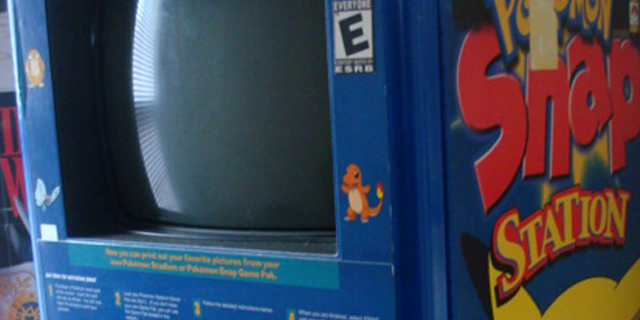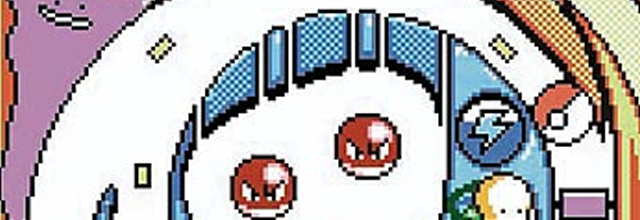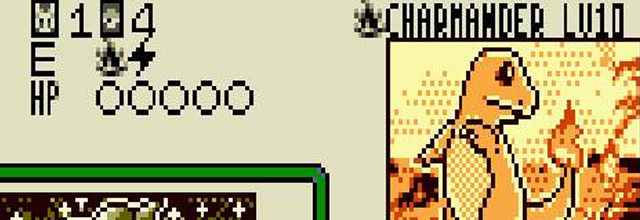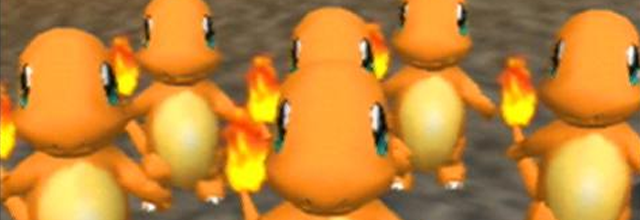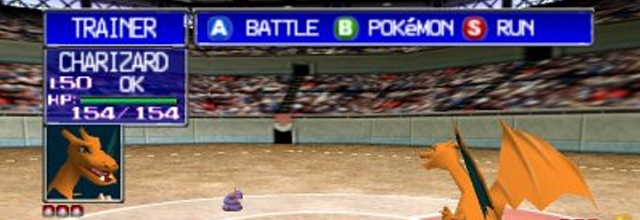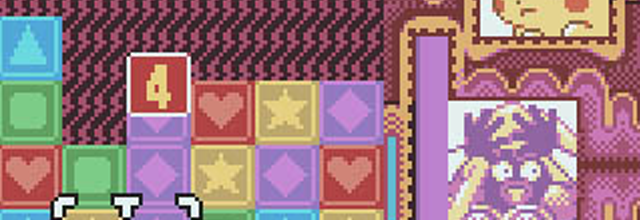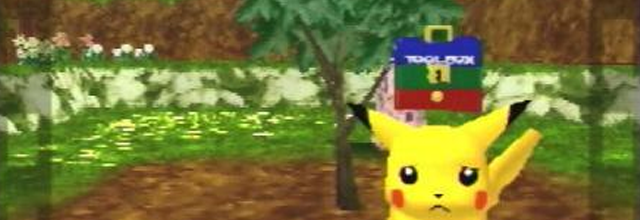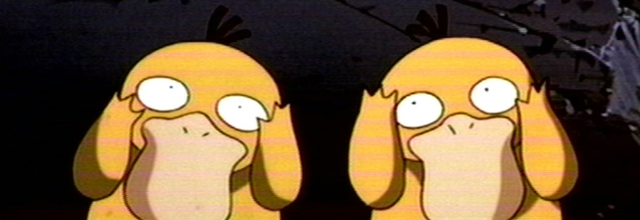There are many ways in which my brain and personality resemble that of a child, but moreso than any is the way I love the things I love. If something manages to capture the attention of my cold and cynical heart for more than a second, there must be something special about it. This happens so rarely that when I truly enjoy something, I just go whole hog. I’ll snatch up the merchandise, play all the games in its canon and wear my love for it proudly on a t-shirt for the world to see. No franchise in history has been more able to engulf my life in this way than Pokemon.
Poke-mania hit America at just the right time in my life when I was its target audience. As an impressionable child, I devoured every bit of Pokemon fandom I could buying up all the cards, games figures and plush toys Electronics Etc. could stock. This is why I loved all the great spinoff games Nintendo was putting out. Even if we were tired of beating Pokemon Blue after the 20th time, we could never get tired of the colorful characters and battle systems. The offshoot Pokemon games allowed gamers to get our fix with a new twist. But at a certain point I stopped playing Pokemon games that weren’t in the main canon. Was this because of the quality of the titles or my access to so many more titles now that I could afford my own video games? Let’s examine some of the games outside of the primary Pokemon releases.
No, not ‘Spinball‘. Just Pokemon Pinball.
A common thread in the Pokemon spinoff canon is ‘Pokemon + an already established thing.’ An even more common thread is the number of video game pinball spinoffs. Kirby had one, so did Metroid and eventually even House of the Dead had a pinball game. But Pokemon’s pinball entry sets itself apart from the others by being deeper than most by integrating themes and game mechanics from the mainline Pokemon games into a pinball framework.
Rather than a steel ball bearing, the player obviously smacks around a tiny Pokeball. By racking up points you’re allowed access to other tables based off towns in the Pokemon world. On each table various Pokemon appear, and obviously you’ve got to catch a lot of them. Actually all of them, if you can. You can even evolve your Pokemon. But what really makes Pokemon Pinball unique is its cart design. The Game Boy Color cart extended out from the back of the GBC and had a rumble pack attached powered by a single AAA battery. As you catapulted the ball across the table, your Game Boy would shake and vibrate to simulate playing a real pinball table. If it were six inches tall and fit in your hands.
Nintendo actually had the balls to do this. Developed by Hudson Soft for the Game Boy Color, Pokemon Trading Card Game put two things together that were already the same thing. This game plays almost exactly like the mainline Pokemon games but swapped out collecting living creatures for tiny flaps of cardboard. This was the point in video games where children started to escape real life by doing the SAME things in their fantasy world they were already doing in the real world.
And before you ask, this tactic absolutely worked on me. Nintendo took the two most addicting pastimes of my childhood and combined them. The game even came packaged with an exclusive Meowth card, so you had to get it. Plus: the game is really good. It was the classic (and not yet tired) Pokemon formula with a twist. Rather than building a team of six Pokemon, you had a whole deck full of monsters, adding lots of variety. Pokemon TCG had a sequel, but it only came out in Japan, so if you dig this and want more be sure to check out Capcom vs. SNK Card Fighters Clash on the Neo Geo Pocket Color. It was basically the same game structure, with SNK and Capcom characters and a few different mechanics.
So far the spin-offs have in some way or another adapted a major game mechanic from the Pokemon series, but Pokemon Snap is entirely its own thing. Professor Oak has commissioned Todd Snap to aide him in his research by photographing pokemon on Pokemon Island. Limited to the movement of the on-rails ZERO-ONE, the player takes pictures of the local wildlife in first person. You’re equipped with apples and pester balls to tempt or taunt a Pokemon into the perfect pose. Sometimes, you can even engineer a series of events to cause Pokemon to fight, party or evolve in front of your very eyes. And if there are some pictures you really like, you can print them out on stickers at Blockbuster. Well you could. When Blockbuster was a thing.
This was not only my favorite Pokemon spinoff, but one of my favorite games of the time. Familiar faces like Pikachu and Psyduck worked well with this unique premise. Many games featured camera modes, but very few are completely based around photography. Pokemon Snap only featured 63 of the original 151 pokemon, but that was plenty to keep you busy with the array of possible poses and events triggered by player actions. If you missed this one (as many seemed to have) pick up a cart, it’s very cheap. And the Virtual Console release allows you to share your photos with other. You can’t print them out on stickers to adorn your Trapper Keeper, but that’s still pretty cool.
Pokemon Stadium is possibly the least inspired of the Nintendo 64 Pokemon spinoffs. There’s nothing wrong with the game, it’s just fairly shallow. Players could upload their Pokemon directly from their copies of Red, Blue or Yellow through the aide of a Transfer Pak that hung off the already-awkward N64 controller like a tumor on another bunch of tumors. Then they could battle. And that was about it. Your Pokemon didn’t gain much by battling in this title, except a cool 3D model and oddly-repetitive battle animations. There were some minigames involved, but none of them were very memorable. And the campaign was just a very stripped-down version of the Game Boy games’ adventure. All this game did for me was cause me to ask for the first time, “Why doesn’t Nintendo make a full console Pokemon title?” A question I ask to this day.
Another entry in the ‘Pokemon + thing that is already a thing’ section is the Pokemon Puzzle series. Based off the Panel de Pon and Tetris Attack games, Pokemon Puzzle League replaced the spritely, girly fairy characters of Panel de Pon with the much more broadly marketable Pokemon. Puzzle League on the N64 is actually a weird title for a few reasons. Despite Pokemon’s popularity in Japan, this title only came out in the US, Europe and Australia. It’s also the first game directly based off the Pokemon anime series featuring characters from the TV show like Tracey, Ritchie and Ash (rather than personality-less trainer Red).
Puzzle League‘s Game Boy Color counterpart, Pokemon Puzzle Challenge, cuts out some features like League’s story mode and TV show characters, but retains the same incredibly addictive Tetris Attack gameplay. Being a portable puzzle game, this title really gives Tetris a run for its money for best/most battery-draining handheld game. Later on the DS we later got Pokemon Trozei. I haven’t actually played this game, but from all accounts it’s a fairly uninspired puzzle game and fails to live up to the Puzzle League series.
This is about where Nintendo started to lose the plot with their Pokemon spinoffs. Rather than feature a classic and known quantity game style or adapt an established Pokemon mechanic into a new genre, some spinoffs just became ideas that seemed cool and were stretched well beyond their means.
In Hey You, Pikachu! the player attempted to guide Pikachu through the use of a microphone attachment with their voice to do things like interact with other Pokemon and play games. I say ‘try’ because he never did what you told him to do. It was kind of like Seaman on the Dreamcast, only way less cool and with way less Leonard Nimoy. There wasn’t much to do with Pikachu in the game, so the novelty of the microphone wore off very quickly. The game also came packaged in a special N64 bundle, with a yellow console that featured Pikachu’s face molded into it. (Though by that point in the console’s life, anyone who wanted one already had it.) I’m sure you’ve seen many of these hideous things in bargain bins and on Craigslist for about eight bucks.
This game later led to Pokemon Channel, a title on the GameCube in which you watched your pokemon watch TV. At least you got to watch your Sims do it once in a while.
There was a while where Nintendo seemed to focus on the mainline Pokemon series and didn’t release many spinoffs. I guess the teams making these games were repurposed to a more useful section of the Pokemon Company like counting money in giant tubs. Then a few years later, within about two years we had the Mystery Dungeon series, Pokemon Ranger, Dash, Trozei and some very poorly-thought-out GameCube and Wii releases. Nintendo really lost it with Pokemon spinoffs for some time, but now things have really picked up. I hear the Mystery Dungeon games and Rumble Blast are pretty good, and frankly I don’t think I could tell you how excited I am for Pokemon + Nobunaga’s Ambition. I pray to Miyamoto every day that this game will see a Stateside release. Don’t hold your breath for a Pokemon MMO, though. That’s just too good of an idea to be real.



